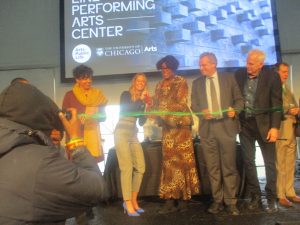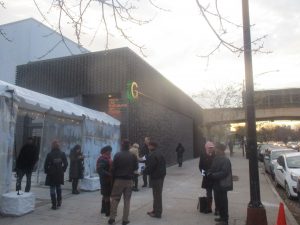Green Line Performing Arts Center opens on Chicago’s South Side
By Igor Studenkov For Chronicle Media — November 27, 2018
Lori Berko (left) and Ald. Patt Dowell (right) prepare to cut the ribbon to mark the opening of the Green Line Art Center. (Photo by Igor Studenkov/for Chronicle Media)
It was almost standing room only during the grand opening of the Green Line Performing Arts Center — and for a good reason. For the first time in decades, Chicago’s Washington Park neighborhood has a dedicated performance space.
As many speakers and attendees noted during the Nov. 10 grand-opening celebration, in Chicago’s South Side, especially the majority-black neighborhoods, local artists and performers don’t have many places to showcase their work. The new facility includes a larger E&A Theatre, a rehearsal space that doubles as a smaller performance area and an outdoor courtyard that will be available for performances and film screenings during warmer months.
The art center is part of University of Chicago’s Art + Public Life initiative’s efforts to turn the area around Garfield Green Line ‘L’ station into an “art block” with several arts and performance spaces. University officials and local politicians touted the art center as a major asset for Washington Park and South side in general. But many residents who spoke to the Chronicle had mixed feeling about the project, saying that, while they are happy the art center is there, they worried that it might be a harbinger of gentrification and displacement to come.
As previously reported by the Chronicle, University of Chicago launched Arts + Public Life initiative in 2011 as part of its broader effort to do more in communities outside Hyde Park. Artist Theaster Gates has been a primary creative force behind the art block, opening the art incubator, Currency Exchange café and Bing Art Books bookstore on the south side of Garfield Boulevard, across the street from the Garfield Green Line ‘L’ station. While the café has since been revamped and Gates turned the bookstore space into a bar, the art incubator has been a consistent presence for the past six years.

Green Line Performing Arts Center will host plays, arts and film screens in Chicago South Side’s Washington Park neighborhood. (Photo by Igor Studenkov/for Chronicle Media)
Garfield ‘L’ station is one of the oldest ‘L’ stations in Chicago. It was part of South Side Elevated Line, the city’s very first ‘L’ line. The station changed a great deal since then, but even as the new platforms and the new station house were built across the street, the original station building was preserved. Arts + Public Life is currently working with the Chicago Transit Authority into a business incubator for “creative entrepreneurs.”
The art center is located directly east of the historic station house. According to the Arts + Public Life press release, over the last few decades, the lot was home to several entertainment venues. Most famously, it was home to Rhumboogie Cafe, a nightclub co-owned by legendary African-American boxer Joe Louis. And the President Theater, a movie theater turned dance hall, was located nearby until 1972.
In addition to serving as a performance venue, the art center will train residents in sound, lighting and scene design aspects of running the theater, as well as in front of the house and back of the house management.
Chicagoans got their first peek at the art center during the Open House Chicago weekend, when the interiors still weren’t quite finished. The Nov. 10 opening marked the first time residents got the chance to see it completed.
To mark the occasion, Art + Public Life held a celebration in a tent set up in the outdoor patio. Residents were welcome to step inside and get a free meal and beverages.
In her opening remarks, Isis Ferguson, the associate director at Arts + Public Life, said that collaboration with the community will be key to the art center’s success.
“We’re looking forward to bring new partnerships and working toward restoring the Garfield Boulevard,” she said.
University of Chicago provost said that it took a decade of hard work to make the art center possible, and thanked everyone involved.
Get your free subscription of the Cook County digital edition
“[The art center] is intended to [create] deep connections and conversations with the community,” he said. “And we think it’s only the beginning. 30 years from now, we may look back on this and say — this is where it all started.”
Ald. Pat Dowell (3rd Ward), whose ward includes the art center and much of Washington Park, said that the art center’s opening was an important milestone for the community.
“Green Line Art Center stands as a symbol of confidence in the bright future of Washington Park and the historic Garfield Boulevard,” she said.
Dowell also applauded Gates and Art +Public Life for taking an approach that “authentically hones the rich legacy of Bronzeville and Washington Park,” as well as for the economic impact the art incubator already had, especially when it comes to opportunities for South Side vendors and “hundreds and hundreds” of local students.

Green Line Performing Arts Center’s lobby has tiny windows in its walls that allow any passerby to get a peek inside. (Photo by Igor Studenkov/for Chronicle Media)
“This approach will not only ensure future success for this center, but [also] the success of thing community,” Dowell said. “I’m proud of creating history at this very important corner.”
Mark Kelly, Chicago Commissioner of Cultural Affairs and Special Events, compared the art center to the city of Florence, Italy, in that, just like the city of Florence led Europe to the Renaissance, the art center will lead to the renaissance in South Side cultural life and innovation.
“We need more theaters on the South side,” he said. “I challenge all of us to [establish] 3-4 theaters on the South Side [next year].”
Lori Berko, Deputy Director of Arts + Public Life, thanked everybody involved, but reserved the biggest thanks for the residents who took part in the art incubator programs and provided “invaluable feedback.”
If there was any consensus among the residents who spoke to the Chronicle was that, if nothing else, the art center was a great asset for the community. Alice Rivers, of Chatham neighborhood further south, applauded it without reservations
“I think it’s fantastic, what’s happening in this community, in such a meaningful way,” she said, adding that she especially appreciates its instructional component.
Felicia Holman grew up in the South Shore neighborhood and currently lives in Bucktown, is a founder and director of Honey Pot Performance dance troupe, which performed at the tent after the ribbon-cutting. She said that, while the art incubator could work for some performances, it wasn’t really set up for it, so it was nice to have a facility that was specifically geared toward performing arts.
“It is very needed — it just makes sense,” she said. “I’m looking forward to seeing what the programming is.
Wendi Hill, of Uptown, said that she appreciated the fact that the art center is close to the ‘L’ station, making it easier for people in the area to reach it. And, from what she saw at the opening, she was struck by just how much it was needed.
Hollman said that one thing she was planning to keep an eye on was how much community participation there is, saying that it was very important to her.
Kial Stovall, of Washington Park, made no bones about her reservations.
“I like the idea of arts in the community, but I do have a concern — gentrification,” she said. “I’ve seen this happen here for several years.”
Stovall said that she has seen her local corner store close down, and her local auto repair shop, which was located “right next door” to the art center, closed down. She had seen gentrification happen in places like the area around what is now known as Guaranteed Rate Field and the neighborhoods by the lake shore. And she was especially concerned about how rising property values would affect the most vulnerable populations, such as the veterans she worked with in the past.
In the end, Stovall said she was torn.
“Art is beautiful, but this is my life, and I’m concerned,” she said. “But it is nice. I will probably come to the concerts.”
Myron Willis, who grew up in Washington Park and currently lives in Hyde Park, said he was impressed with the center.
“It’s wonderful, it’s awesome,” he said. “It’s revitalizing the South Side. [Washington Park] was the neighborhood you didn’t come to, now look at it.”
But when asked if he had any concerns about gentrification and displacement, Willis shrugged. As far as he was concerned, it was something that would happen sooner or later.
“I’m not worried about it,” he said. “I just think it’s going to change. I think it’s unfortunate for [poor residents]. But then, the artistic loft building is already next food, and that’s a good thing. “







